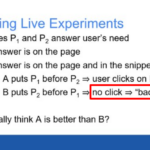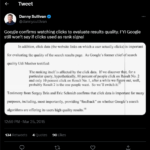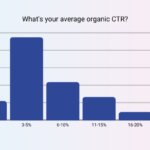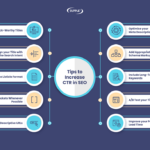Click Through Rate in SEO: What it is and How to Increase It?
Here’s an unfortunate truth nobody in the SEO industry likes to hear — being on the first page of Google SERPs (search engine result pages) won’t amount to much if searchers are not clicking on your link.
Simply put, if searchers are discovering your website in search results but not engaging with it, your click through rate (CTR) is going to remain low.
That’s why we always recommend giving equal attention to improving your click through rate, instead of focusing all your efforts on trying to secure the top spot in Google search results
That said, if you’re new to SEO and don’t know what is click through rate, you’re not alone!
In this post, we’ll explore the click through rate in detail, and discuss some tips on how to increase the CTR of your website.
What is Click Through Rate?
click through rate (CTR) is defined as the percentage of searchers who click on your search engine result.
The click through rate of your website largely depends on your search engine rankings, meaning the higher you rank on Google SERPs, the more searchers are likely to click on your search result.
However, the click through rate can be heavily influenced by your title tag, meta description, URL, and the presence of rich snippets.
Suppose your website is receiving 10 clicks at the number #3 position, while the number #1 search result is receiving 50 clicks.
In this case, you can optimise your title tag, meta description and URL, and add appropriate schema markup to stand out in Google SERP and increase your click through rate.
How to Calculate Click Through Rate?
Calculating the click through rate of your website is fairly easy.
All you have to do is divide the number of clicks on your search engine result by the number of times it was shown to searchers. Then, multiply that number by 100 to get your CTR percentage.
Here’s the click through rate calculation formula —
Click Through Rate (CTR) = (Total number of clicks / Total number of impressions) x 100.
That means, if your search result was displayed 1,000 times and received 40 clicks, the CTR would be 4%.
Why is Click Through Rate Important?
There are multiple reasons why improving click through rates is important.
For starters, the share of clicks in search results is on a constant decline, all thanks to rising SERP features and the fact that Google is making PPC ads look more and more like organic search results.
Because of this, it’s becoming more critical for SEOs to squeeze out every bit of clicks they possibly can.
Secondly, improving your click through rate directly increases organic traffic to your website without necessarily having to improve your search engine rankings.
Simply put, the higher your click through rate is, the more searchers will visit your website.
Most importantly, the click through rate is one of the direct SEO ranking factors.
According to research by Moz, there is a strong correlation between expected CTR and search engine rankings.
That means, if your web page can beat the expected organic CTR for a given ranking, the more likely you are to appear in higher search results.
Besides, Google itself has made statements more than once indicating that they do use CTR in their search algorithm.
For example, a Google Engineer named Paul Haahr once mentioned that they use CTR to figure out what type of search results searchers want to see.

As you can see in the screenshot above, the slide literally says that if searchers don’t click, it’s bad for your search result.
Apart from this, Danny Sullivan who is Google’s Search Liaison also tweeted that they use CTR as a ranking signal.

Based on this, it’s clear that improving CTR can result in higher search engine rankings and increased organic traffic.
What is a Good Click Through Rate?
According to Databox research, most websites on the internet have an average of 3-5% click through rate. That means anything higher than 5% can be considered a good organic click through rate.

It goes without saying that the first position on the search engine results page (SERP) tends to have the highest CTR, with an average of almost 40%.
The CTR for lower positions drops off significantly, with the second position typically receiving around half the CTR of the first position.
The good news is, you don’t necessarily have to improve your search engine rankings in order to attain higher than average CTR for Google search.
There are plenty of other ways to increase CTR in SEO such as optimising on-page SEO elements like title tags, URL and meta descriptions, matching search intent and utilising appropriate schema markup to target rich snippets.
Below, we’ve shared 10 such tips on how to increase CTR in SEO for organic search.
Tips on How to Increase CTR in SEO for Organic Search

As SEO becomes increasingly competitive, it’s important to ensure that your website stands out on the SERPs. One way to achieve this is by increasing your click through rate.
Here are the top ten tips on how to increase CTR in SEO for organic search and increase your website traffic.
1 – Write Click-Worthy Titles
The title of your webpage is the first thing a user sees on the SERP, so it’s essential to create a title that grabs their attention.
Creating a click-worthy title that accurately describes what your web page is about can encourage users to click through to your site.
There are several tactics you can use to write click-worthy titles for your web pages.
For starters, use words and phrases that your target audience uses to search on Google. You can also consider using emotional triggers such as curiosity, urgency, or surprise to pique the user’s interest.
Just remember to keep your title tags concise and avoid using filler words or phrases that do not add value.
2 – Align your Title with the Search Intent
Search intent is the reason behind a user’s search query, and it is important to understand it when creating your title.
Users may have informational, navigational, or transactional search intent.
For the uninitiated, informational search intent is when users are seeking information about a particular topic, navigational search intent is when users are looking for a specific website, and transactional search intent is when users are looking to purchase a product or service.
For example, if someone searches for the “best SEO agency in Sydney“, their search intent is to find the SEO services provider in Sydney.
Remember, understanding the user’s search intent can help you create a title that accurately reflects the content of your webpage and aligns with their expectations.
Ensuring that your title matches the user’s search intent increases the likelihood of them clicking through to your website.
3 – Use Listicle Format
Searchers love listicles.
In fact, research has also found that list posts get 80% more organic clicks than other types of articles. That’s mainly because listicles provide a quick and easy way to consume information.
Apart from this, listicles can also improve SEO by increasing time spent on the site, reducing bounce rates, and increasing social shares.
These factors can signal to Google that your content is valuable and relevant, which can lead to higher search rankings and increased click through rates.
Therefore, we highly recommend using numbers in your title tags to indicate a list format such as “Top WordPress SEO Strategies” or “Best DIY Marketing Tools”.
Doing so will make your title tags more click-worthy and your content easy to skim.
4 – Add Brackets Whenever Possible
Adding brackets to your title can significantlCy increase your CTR.
Brackets make your titles stand out from other titles on the SERP, and they also give users a clear idea of what they can expect from your content.
For example, instead of writing your title tag like “Top SEO Strategies for your SaaS Company”, add brackets like this ” Top SaaS SEO Strategies [2023 Edition]”.
Adding brackets to your title tag will make it more specific, and searchers are more likely to click on it because it is up to date.
5 – Create Descriptive URLs
Your website’s URL is one of the top three things searchers see on Google SERPs.
Therefore, it is critical to create descriptive URLs that give users an idea of what your content is about. More importantly, a descriptive URL is also more likely to be clicked on by your target audience.
For example, if you’re writing a blog post on “Top Link Building Strategies That Work [Updated for 2023], create a descriptive URL such as “www.yourwebsite.com/link-building-strategies” instead of using the default “www.yourwebsite.com/blog-154253”.
Doing so will help Google easily understand what your blog post is about and will rank it for relevant search terms.
More importantly, searchers are also more likely to click on descriptive URLs rather than the default ones.
6 – Optimise your Meta Description
Another strategic way to increase your click through rate is by optimising your meta description.
For the uninitiated, meta description is the short summary of your content that appears below your URL on the SERPs. A well-optimised meta description can not only improve your search engine rankings but also entice searchers to click on your link.
To optimise your meta description, make sure it accurately describes your content and includes your target keyword.
Apart from this, consider using power words like “proven”, “ultimate”, or “best” to make your description more compelling.
While writing meta descriptions make sure not to go over the character limit (150-156 characters). Otherwise, the ending part will get truncated by Google.
7 – Add Appropriate Schema Markup
Also known as structured data, schema markup is a language that search engines like Google, Bing, etc. use to read and understand what a web page is about.
In other words, it’s a semantic vocabulary that allows Google to categorise the content of web pages.
By adding appropriate schema markup, you can provide additional context to your content and help search engines display rich snippets in the search results.
For the uninitiated, rich snippets are a type of search results that include additional information beyond the page title and meta description.
There are various different types of schema markup you can add to your web pages such as products, reviews, cooking recipes, videos etc.
Doing so will increase the chances of your web pages appearing as rich snippets in the search results, which can lead to higher click through rates.
8 – Include Long-Tail Keywords
Including long-tail keywords in your content can help to improve your click through rates and attract more targeted traffic to your website.
Long-tail keywords are longer and more specific keyword phrases that users may search for when looking for a particular product or service.
Searchers use long-tail keywords in their search queries when they’re already in the buying process and more likely to convert.
For example, if you sell running shoes, targeting a long-tail keyword like “best running shoes for flat feet” instead of “best running shoes” may attract users who are looking for a specific type of shoe and are more likely to make a purchase.
The best part? — Long-tail keywords tend to have less competition, which means that ranking for long-tail keywords can be easier than ranking for more competitive keywords.
Plus, when searchers see a search result that matches their query more closely, they are more likely to click through to the website.
9 – A/B Test your Titles
As explained earlier, the title tag of your web page is one of the most important factors that influence click through rates.
Therefore, it’s important to make sure your titles are engaging, informative, and optimised for higher click through rates.
One way to achieve this is through A/B testing your titles. As the name suggests, it involves creating two or more versions of titles for the same web page and testing each title for a specific period of time to see which version generated more clicks and traffic to your website.
By A/B testing your titles, you can identify which titles are most effective at generating clicks and traffic.
These insights can later be used to optimise your titles for higher click through rates, which can lead to increased organic traffic and improved SEO performance.
10 – Improve your Page Load Time
The speed at which your web pages load is another critical factor that can impact your click through rates. Slow page load times can frustrate users and make them more likely to click away from your website.
According to Think with Google, 53% of visitors abandon a website if it takes more than 3 seconds to load.
That means, if your website is not optimised for speed, people may click on your search results in SERP but will bounce off if they have to wait longer than 3 seconds.
As a result, it will affect your organic CTR as well as your search engine rankings.
Therefore, we highly recommend analysing your website loading time using any of the speed test tools and performing page speed optimisation if it takes longer than 3 seconds to load.
Boost Your Organic Click Through Rates!
click through rate plays a critical role in the success of an SEO strategy. Hopefully, implementing will these tips will help you in increasing your CTR for organic search and boost your website traffic.
That said, if you’re still not sure how to get started or looking for an SEO agency to manage your marketing campaign and increase website traffic, Supple can help!
Feel free to reach out to us at any time for professional consultation on how to increase your CTR and organic traffic to your website and skyrocket your revenue.
DIGITAL MARKETING FOR ALL OF AUSTRALIA
- SEO AgencyMelbourne
- SEO AgencySydney
- SEO AgencyBrisbane
- SEO AgencyAdelaide
- SEO AgencyPerth
- SEO AgencyCanberra
- SEO AgencyHobart
- SEO AgencyDarwin
- SEO AgencyGold Coast
- We work with all businesses across Australia




